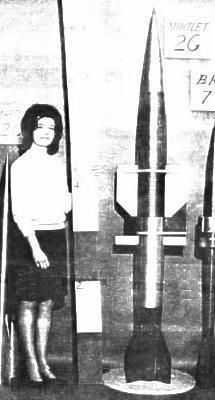
Home - Search - Browse - Alphabetic Index: 0- 1- 2- 3- 4- 5- 6- 7- 8- 9
A- B- C- D- E- F- G- H- I- J- K- L- M- N- O- P- Q- R- S- T- U- V- W- X- Y- Z
Martlet 2G
 Martlet 2G |
Status: Hardware 1967. Payload: 160 kg (350 lb). Gross mass: 159 kg (350 lb). Height: 2.27 m (7.44 ft). Diameter: 0.18 m (0.59 ft). Apogee: 200 km (120 mi).
Although the Martlet 2 series had adequate payload capacity for its primary scientific mission, it was understood from the first flights that the heavy pusher plate, petal arms, and sabot represented a sub-optimal vehicle configuration . About half of the all-up launch weight consisted of the sabot which was promptly discarded after launch. If more of the launch mass was retained after launch a larger vehicle with a greater payload capacity would result - without an increase in the launch weight and without the need to prototype a new gun propellant configuration.
As the HARP Program proceeded a low-priority development program was conducted for a new vehicle with a much lighter center sabot. This vehicle was designated the Martlet 2G and its design was substantially based on the probes flown on the smaller 5" and 7" HARP guns.
The Martlet 2G had the same launch weight as the earlier Martlet 2's but nearly twice the flight weight and a substantially increased payload capacity. The flight envelope of the Martlet 2G was intended to be identical to the earlier Martlet 2 with a maximum theoretical apogee of 200 km. Only 12 operational Martlet 2G's were flown. Although none of these flights were high altitude tests, the basic concept of the Martlet 2G vehicle configuration was proven.
The Martlet 2G was a dart shaped vehicle 2.27 m (89.5") long and 18 cm (7") in diameter with a flight weight of 159 kg (350 lb). In the place of the earlier pusher plate and petal arms the Martlet 2G used a much lighter center sabot. This consisted of four blocks that were attached to the vehicle near the center of balance with each block occupying 90 degrees of the bore circumference. The Martlet 2G sabot was about 46 cm (18") long and was manufactured from three components:
- A sabot crown, made of aluminum and mated to the vehicle body using buttress threads.
- A sabot base, made of polycarbonate and machined slightly oversized so that it could be force-fitted into the bore.
- A polythene obdurator, to seal the gun gases.
After the vehicle had exited the gun muzzle, aerodynamic forces would peel the sabot sections away from the body, freeing it for ballistic flight to apogee. With this type of sabot the tail end of the vehicle was allowed to trail in the gun gases during the launch. It was found that the short duration exposure to the gun gases posed no substantial hazard to vehicle's flight performance.
by Richard K Graf
Payload: 160 kg (350 lb) to a 200 km altitude. Launch Price $: 0.003 million in 1965 dollars. Total Development Built: 12.
Family: Gun-launched. Country: Canada. Agency: Bull.
Back to top of page
Home - Search - Browse - Alphabetic Index: 0- 1- 2- 3- 4- 5- 6- 7- 8- 9
A- B- C- D- E- F- G- H- I- J- K- L- M- N- O- P- Q- R- S- T- U- V- W- X- Y- Z
© 1997-2019 Mark Wade - Contact
© / Conditions for Use